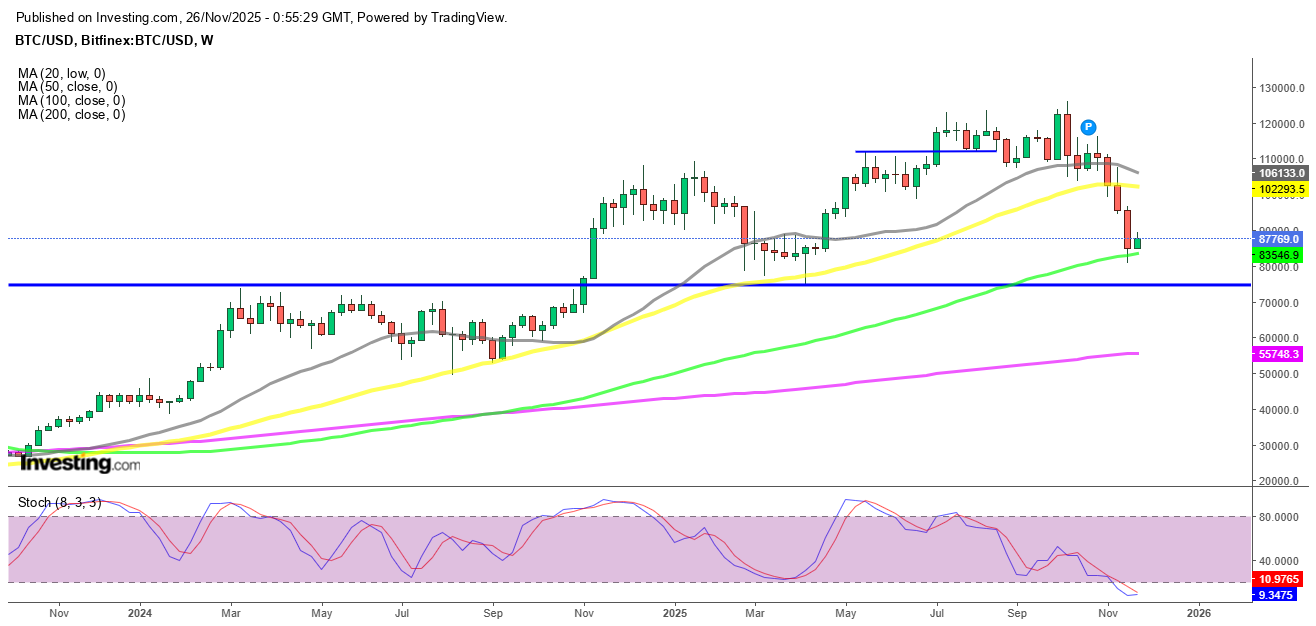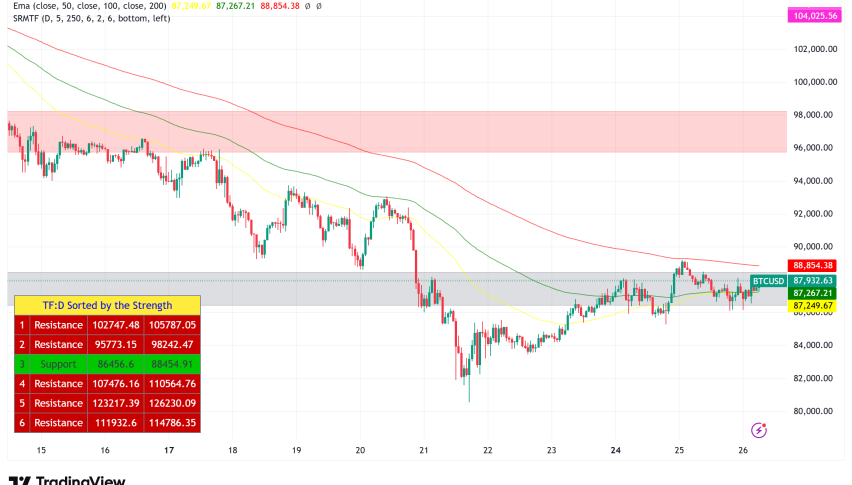Forex Signals Nov 25: RBNZ Interest Rate Cut Sends NZD Up As Australian Inflation Spikes
Shifting rate expectations in New Zealand, an inflation surprise in Australia, and softer U.S. data are combining to drive a new wave of...

Quick overview
- Shifting rate expectations in New Zealand and an inflation surprise in Australia are contributing to increased volatility in global markets.
- Softer-than-expected U.S. economic data has raised market expectations for a near-term rate cut by the Federal Reserve.
- Australian inflation figures have eliminated near-term expectations for rate cuts from the Reserve Bank of Australia, causing the Australian dollar to rise.
- The Reserve Bank of New Zealand is expected to implement another rate cut amid signs of weakening economic momentum and rising unemployment.
Live BTC/USD Chart
Shifting rate expectations in New Zealand, an inflation surprise in Australia, and softer U.S. data are combining to drive a new wave of volatility across currencies and global equities.
US Data Shifts the Rate Outlook
The US dollar moved lower following a string of softer-than-expected economic readings, pushing market expectations for a near-term rate cut up to around 83%. September retail and food services sales rose just 0.2%, well below consensus, while the control group — a key input into GDP — slipped by 0.1% against expectations for a modest increase.
On the inflation front, producer prices climbed 0.3% for the month, driven largely by a jump in energy costs. However, core PPI rose only 0.2%, and annual price pressures remained contained at 2.7%. Together, the data reinforced the view that demand is cooling and that the Federal Reserve may soon pivot toward easing.
Tech Headlines Rattle Early Equity Sentiment
Markets opened the session under pressure as reports emerged that Google and Meta were in talks that could shift future AI workloads away from Nvidia and AMD, instead relying more heavily on Google’s custom Tensor Processing Units. The potential change in supply chains weighed heavily on chipmakers, with Nvidia and AMD closing lower on the day and approaching key technical levels.
Broadcom moved in the opposite direction, benefiting from its manufacturing exposure to Google’s chips, while Meta rallied strongly as lower compute costs could ease pressure on its capital spending plans.
Despite the early weakness, sentiment recovered as the session progressed. All major US indices ultimately finished in positive territory, led by strong gains in the Dow, followed by the S&P 500 and the Nasdaq.
Key Market Events to Watch Tuesday:
Australian Inflation Sends a Strong Signal
In Australia, the focus shifted firmly onto inflation. October CPI printed hotter than expected, with headline inflation coming in at 3.8% year-over-year, well above forecasts and outside the Reserve Bank of Australia’s 2–3% target band.
Even more concerning for policymakers was core inflation. The trimmed mean measure rose to 3.3% annually with a monthly increase of 0.3%, underscoring persistent price pressure across the economy.
These figures effectively eliminated any near-term expectations for RBA rate cuts. In response, the Australian dollar jumped, and bond markets rapidly repriced for a longer period of elevated rates.
RBNZ Set to Ease Again
Across the Tasman, attention is turning to the Reserve Bank of New Zealand, which is widely expected to deliver another 25 basis point rate cut at its final meeting of the year, bringing the Official Cash Rate down to 2.25%.
The decision follows October’s larger-than-usual 50 basis point cut, which was implemented in response to signs of weakening economic momentum. The latest labour market data shows cooling conditions, with unemployment rising to 5.3%, wage growth softening, and employment declining over the past year.
While headline inflation has shown an uptick, many analysts believe it is temporary. Westpac expects the RBNZ to lower its projected interest-rate path by around 30–35 basis points, which would take the forecast low for the OCR to roughly 2.20% in early 2026.
However, uncertainty remains high. Policymakers will need to balance rising unemployment and slowing growth against the risk that inflation expectations become unanchored. This tension could even result in a split vote between those favoring a 25 basis point cut and others pushing for a larger move.
Last week, markets were quite volatile again, with gold finding support at $4,000. EUR/USD stayed above 1.16 while main indices closed the week higher at new records. The moves weren’t too big though, and we opened 35 trading signals in total, finishing the week with 28 winning signals and 9 losing ones.
Gold Stabilizes
Although demand for safe haven assets is still high, gold fell precipitously from record highs following the Fed’s most recent rate cut comments, as profit-taking was prompted by Powell’s cautious tone. Earlier this month, gold jumped above $4.3800 following the Federal Reserve’s announcement of a 25 basis point rate decrease. But the impetus soon waned, and prices dropped back to $4,004. The 20 daily SMA (gray) held as support last week, but it gave way yesterday as sellers pushed Gold below $3,900 but buyers returned and pushed XAU above $4,000K.
USD/JPY Remains in Uptrend
Foreign exchange markets saw sharp swings. Early in the week, U.S. yield differentials and Japanese capital outflows pushed the dollar above ¥150, but disappointing U.S. jobs data triggered profit-taking, causing the USD/JPY to slide by four yen from its peak. However, the new BOJ governor the JPY has weakened and USD/JPY soared to 154 and we decided to close our buy signal for more than 80 pips.
USD/JPY – Weekly Chart
Cryptocurrency Update
Bitcoin Finds Support
Cryptocurrencies remained highly active over the summer. Bitcoin (BTC) climbed to fresh highs of $123,000 and $124,000 in July and August, supported by institutional inflows and technical strength. However, remarks from Treasury Secretary Scott Bessent ruling out U.S. increases to BTC reserves triggered a steep pullback, sending the coin down below $105,000 before finding support at the 200 daily SMA (purple) and recovering above $115,000 but then fell toward $100K again. However over the weekend BTC started to rebound off the $10oK again and the price climbed above $106K but reversed lower and yesterday BTC fell close to $90K, breaking the 50 weekly SMA too.
BTC/USD – Weekly Chart
Ethereum Stays Close to $3,000
Ethereum (ETH) has been similarly strong, surging toward $4,800, its highest since 2021 and near its all-time peak of $4,860. Despite a dip last week, ETH found support at the 20-day SMA, with retail enthusiasm and renewed institutional participation driving fresh upside momentum. This Week we saw a dive below $3.500 as ETH heads below $3,000.
ETH/USD – Daily Chart
- Check out our free forex signals
- Follow the top economic events on FX Leaders economic calendar
- Trade better, discover more Forex Trading Strategies
- Open a FREE Trading Account



